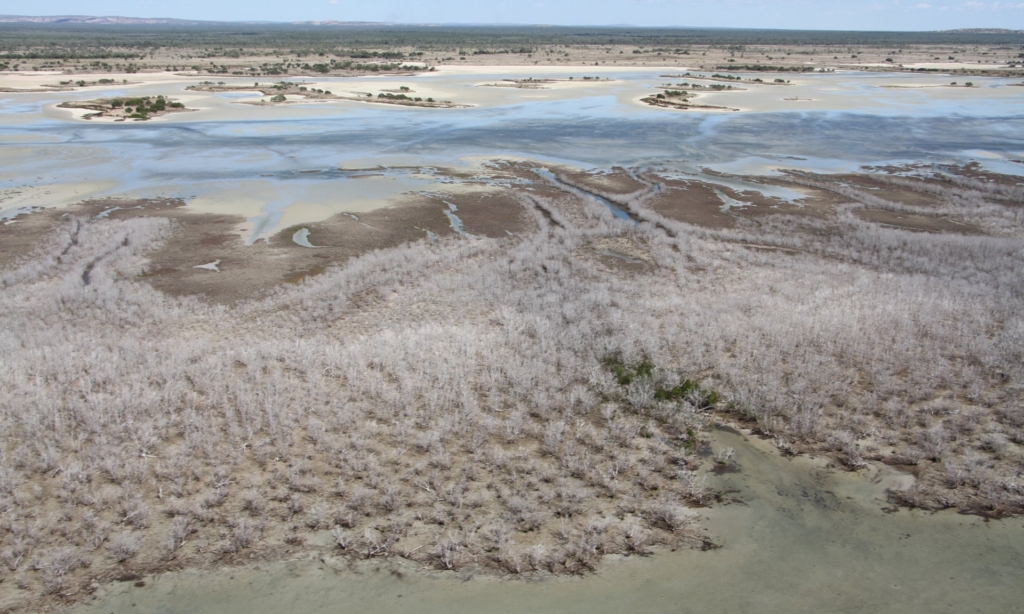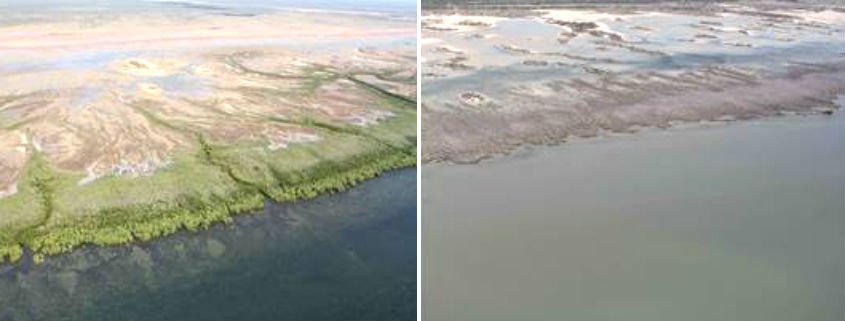Unexpected consequences from catastrophic mangrove dieback – “What was concerning was that the dead mangrove forest emitted about eight times more methane than the living forest”

9
July, 2019
4
July 2019 (Southern Cross University) – When swathes of mangrove
forests died along a 1000 kilometre stretch of coastline in northern
Australia’s Gulf of Carpentaria, there was widespread shock.
But
the impacts of the catastrophic climate-induced mangrove dieback
didn’t end there. In a world first, researchers from Southern Cross
University have found that the dead trees released significant
amounts of the potent greenhouse gas methane.
The results,
published in a leading international journal New
Phytologist,
revealed that while living mangroves emit some methane, dead
mangroves emit about eight times more.
Methane
emissions from mangrove tree-stems have never been quantified until
now.
“The
findings were a surprise,” said lead author and PhD candidate Luke
Jeffrey. “Currently very little is known about the role of
tree-stem methane emissions globally and quantifying these from
mangrove tree-stems has never been attempted.
“Due
to the unique nature of the dieback event, we were able to compare
methane tree-stem emissions from living and dead mangrove forests.
This allowed us to understand what happens when climatic-change
stressors result in forest mortality.
“What
was concerning was that the dead mangrove forest emitted about eight
times more methane than the living forest.”


The
findings have implications for scientific understanding of how
mangrove systems sequester ‘blue carbon’, which is carbon dioxide
absorbed from the atmosphere and locked up in coastal wetlands such
as mangroves.
“As
the climate changes into the future, we may see events like the
catastrophic dieback of mangroves in the Gulf of Carpentaria becoming
the norm. This has significant implications for greenhouse gas
emissions from these valuable coastal habitats,” Mr Jeffrey said.
This
study completes the final chapter of Luke Jeffrey’s PhD thesis with
Southern Cross University and was funded by the Australian Research
Council. His thesis is entitled ‘The drivers and dynamics of
methane and carbon dioxide in disturbed coastal wetlands’.
Contact
-
Jessica Nelson, 0417 288 794, jessica.nelson@scu.edu.au
Are methane emissions from mangrove stems a cryptic carbon loss pathway? Insights from a catastrophic forest mortality
ABSTRACT:
Growing evidence indicates tree‐stem methane emissions may be an
important and unaccounted for component of local, regional and global
carbon budgets. Studies to date have focussed on upland and
freshwater swamp‐forests; however, no data on tree‐stem fluxes
from estuarine species currently exist. Here we provide the
first‐ever mangrove tree‐stem methane flux measurements from >50
trees (n=230 measurements), in both standing dead and living forest,
from a region suffering a recent large‐scale climate‐driven
dieback event (Gulf of Carpentaria, Australia). Average methane
emissions from standing dead mangrove tree‐stems were 249.2 ± 41.0
μmol m−2 d−1 and eight‐fold higher than from living
mangrove tree‐stems (37.5 ± 5.8 μmol m−2 d−1). The
average methane flux from tree‐stem bases (~10cm above ground) was
1071.1 ± 210.4 μmol m−2 d−1 and 96.8 ± 27.7 μmol
m−2 d−1 from dead and living stands respectively.
Sediment methane fluxes and redox potentials did not differ
significantly between living and dead stands.
Our results suggest
both dead and living tree‐stems act as methane conduits to the
atmosphere, bypassing potential sedimentary oxidation processes.
Although large uncertainties exist when up‐scaling data from
small‐scale temporal measurements, we estimated that dead mangrove
tree‐stem emissions may account for ~26% of the net ecosystem
methane flux.



No comments:
Post a Comment
Note: only a member of this blog may post a comment.